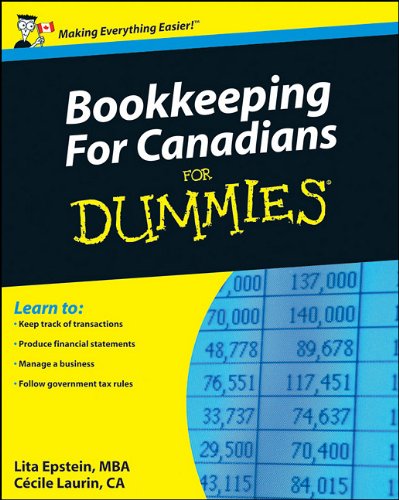Bookkeeping For Canadians For Dummies Business and Personal Finance 1st Edition by Lita Epstein, Cecile Laurin ISBN 1119522137 9781119522133 by Lita Epstein, Cecile Laurin 9780470737620, 047073762X instant download after payment.
Bookkeeping For Canadians For Dummies Business & Personal Finance 1st Edition by Lita Epstein, Cecile Laurin - Ebook PDF Instant Download/Delivery: 1119522137, 9781119522133
Full download Bookkeeping For Canadians For Dummies Business & Personal Finance 1st Edition after payment

Product details:
ISBN 10: 1119522137
ISBN 13: 9781119522133
Author: Lita Epstein, Cecile Laurin
Bookkeeping is an essential skill required in every industry, with a certain concentration in wholesale and retail trade, manufacturing, payroll services, accounting and tax preparation. If you’re a small business owner looking for clear and concise instructions on keeping the books, tracking transactions, recognizing assets and liabilities and keeping ledgers and journals, this book is your one-stop guide to making it easier!
Bookkeeping For Canadians For Dummies covers how to create financial statements and also shows how to operate accounts for businesses. In addition, it teaches you how to recognize the assets and liabilities to the business.
- Keep the books
- Track transactions
- Compete against larger competitors
- Stay on top of journals
Small business owners keeping their own books will rejoice to have this handy guide by their side!
Table of contents:
Part I: Getting Started with Bookkeeping Basics
- Chapter 1: Bookkeeping: Why You Need It and What It Is
- Understanding the purpose of bookkeeping
- Key terms and concepts in bookkeeping
- Who needs bookkeeping (small businesses, self-employed, etc.)
- Chapter 2: Understanding the Accounting Cycle
- Overview of the steps in the accounting cycle
- The role of transactions
- Chapter 3: Debits and Credits: The Heart of Double-Entry Bookkeeping
- The accounting equation (Assets = Liabilities + Equity)
- How debits and credits work
- Types of accounts (asset, liability, equity, revenue, expense)
- Chapter 4: Setting Up Your Chart of Accounts
- What is a Chart of Accounts?
- Designing a Chart of Accounts for your business
- Chapter 5: Choosing Your Bookkeeping System (Manual or Computerized)
- Pros and cons of manual bookkeeping
- Introduction to accounting software (e.g., QuickBooks, Sage 50 - Canadian versions)
- Making the right software choice
Part II: Tracking Day-to-Day Business Operations
- Chapter 6: Keeping Journals: The First Step in Recording Transactions
- Understanding different types of journals (sales, purchases, cash receipts, cash disbursements, general journal)
- Recording transactions in journals
- Chapter 7: Posting Entries to the General Ledger
- The purpose of the General Ledger
- How to post entries from journals to the ledger
- Chapter 8: Handling Cash: Receipts and Payments
- Managing cash inflows and outflows
- Bank reconciliations
- Controlling cash within your business
- Chapter 9: Managing Purchases and Accounts Payable
- Recording purchases and expenses
- Tracking what you owe (Accounts Payable)
- Paying your bills accurately and on time
- Chapter 10: Handling Sales and Accounts Receivable
- Recording sales (cash and credit)
- Tracking what's owed to you (Accounts Receivable)
- Strategies for collecting payments
- Chapter 11: Keeping Track of Inventory
- Inventory valuation methods (FIFO, LIFO, Weighted Average)
- Inventory control and management
- Chapter 12: Dealing with Payroll in Canada
- Understanding Canadian payroll regulations
- Calculating and remitting EI, CPP/QPP, and income tax
- Employee benefits, commissions, and gratuities
Part III: Preparing the Books for Year's (or Month's) End
- Chapter 13: Adjusting Entries: Getting Your Books Ready
- Why adjusting entries are necessary
- Types of adjusting entries (accruals, deferrals, depreciation)
- Chapter 14: Depreciating Assets
- Understanding capital assets and depreciation
- Methods of depreciation
- Capital Cost Allowance (CCA) in Canada
- Chapter 15: Interest, Loans, and Other Financial Transactions
- Recording interest income and expense
- Handling loans and debt
- Chapter 16: The Trial Balance: Checking Your Work
- Purpose and preparation of a trial balance
- Identifying and correcting errors
Part IV: Reporting Results and Starting Over
- Chapter 17: Preparing the Income Statement (Profit & Loss Statement)
- Components of the Income Statement
- Analyzing profitability
- Chapter 18: Understanding the Balance Sheet
- Components of the Balance Sheet (Assets, Liabilities, Equity)
- Interpreting financial position
- Chapter 19: Mastering the Cash Flow Statement
- Operating, investing, and financing activities
- Understanding cash flow movements
- Chapter 20: Closing the Books and Starting a New Accounting Cycle
- The closing process
- Preparing for the next period
Part V: The Part of Tens
-
Chapter 21: Ten Essential Bookkeeping Forms and Records
-
Chapter 22: Ten Ways to Safeguard Your Business's Money
-
Chapter 23: Ten Common Bookkeeping Mistakes to Avoid
-
Chapter 24: Ten Tips for Working with Your Accountant (and the CRA)
People also search for:
bookkeeping for canadians for dummies
how to start a bookkeeping business in canada
how to do bookkeeping for small business in canada
bookkeeping for dummies canada
bookkeeping for dummies 2021
Tags: Lita Epstein, Cecile Laurin, Bookkeeping, Canadians



